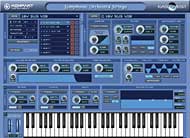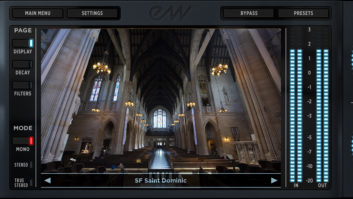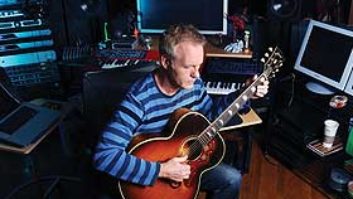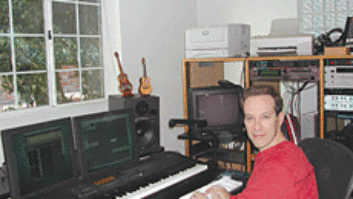
The library is designed to be played using a keyboard and mod wheel, controlled here in Native Instruments’ Kompakt.
The EastWest Quantum Leap Symphonic Orchestra (EWQLSO) takes the concept of sampling to the next level. The disk streaming library offers recordings from three vantage points that can be combined to manipulate each instrument’s perspective. The orchestral players were recorded in a concert hall in their normal positions and each instrument was recorded with three stereo mic setups: spot mics (C, or Close programs), a Decca tree array in the front-of-stage position above the conductor (F, or Full programs) and back of the hall (S, or Surround).
Producers Nick Phoenix of Quantum Leap and Doug Rogers of EastWest hired top-notch classical engineer Keith Johnson, who used his considerable skills and arsenal of custom-built equipment to record EWQLSO. The library’s huge and very real sound is probably its biggest selling point — it literally gave me an adrenaline rush when I sat down to play some of its instruments.
A VERSION FOR EVERYONE
EWQLSO is offered in three versions. Each (or each orchestral section in the top-line Platinum version) comes as a virtual instrument in its own dedicated Native Instruments Kompakt sample player. For more extensive editing, you can open EWQLSO in Native Instruments’ Kontakt, which can load 16 instruments per instance vs. Kompakt’s eight, so it’s also more efficient with memory when multiple programs share the same loaded samples.
The Platinum edition ($2,995) is about 67 GB and includes all three phase-coherent mic positions to mix and match. You can license the entire orchestra or purchase each Platinum edition section (strings, winds, brass, percussion) separately.
At roughly one third the price of Platinum edition, EastWest offers the Gold edition ($995), weighing in at about 14.5 GB. It includes almost all of the instruments and articulations in Platinum, except it has just the Full programs and is in 16-bit format.
A $295 Silver edition offers a handful of Gold and Platinum’s articulations and is intended to be used by schools or composers who need a laptop-friendly version with much lower system requirements.
OUTSTANDING INSTRUMENTS
EWQLSO provides characteristic articulations unique to each instrument. EastWest recorded the standard long and short notes, as well as specialized articulations such as string “blooms” (short swells with heavy vibrato) of various lengths.
There are a lot of these articulations to choose from, and they’re great when they happen to fit your tempo and context. When they don’t, you just have to work harder with the standard articulations.
The library is intended to be played using just a keyboard and mod wheel, plus MIDI CC#11 volume-riding. Most instruments feature mod wheel crossfades between dynamic layers and a couple of keyswitch programs. (Keyswitches are on-the-fly instrument changes triggered by notes on an unused portion of the keyboard.)
There are too many highlights in EWQLSO to list, but I’ll start by saying that the percussion blew me away. Johnson managed to record the biggest, booty-shakingest concert bass drums you’ve ever heard, the timps rock the house, the orchestra bells are terrific and the orchestral toms are testosterone-laden.
The low strings are to die for, and with the exception of a few high string articulations that can sound synthetic, the whole string library sounds very realistic if you select the right articulations and “program” the dynamics well. In general, I preferred the grittier sound of the 11-piece second violin to the 18-piece first violins, but it’s great having the choice.
Some of the woodwinds, such as the piccolo, are as good as the rest of the library, while others, such as the overly buzzy contrabassoon, struck me as sounding less convincing than the other sections. This is not always noticeable “in the mix,” but it is when you play some of the instruments individually. My hunch is that different halls and studios simply work better for recording different instruments, but the players seem to be very good.
The brass is powerful, huge and very exciting to play. In addition to big sections (six French horns, three tubas, a trombone section extended by a muscular bass trombones, etc.), solo instruments are included. I had a blast overusing the Wagner tuba octave unison rips.
BALANCING AND MIXING OPTIONS
Cues using only the Full programs sound mixed and pretty well-finished out of the box if you just balance the instruments’ levels. When required, you can shorten, lengthen or adjust the release trails’ levels in Kompakt. You can also use its built-in filters on individual sample layers to avoid having external equalization affect the recorded ambience along with the “direct” signal.
Being able to mix in some of the other mic positions adds considerable flexibility to Platinum. You can use the Close mic programs for solo passages or you can mix them in very low to add definition to ensemble passages. For the latter, Johnson suggests highpassing them and boosting the top end slightly. He also suggests mixing in a hint of the brightened C programs at the beginning of important ensemble lines to help establish them.
The Surround programs are intended to then go to the rear speakers in 5.1 mixes, with the Full programs in the front and one channel of the Close programs in the center. You can also use the S programs for extra ambience or to move sounds farther away in a stereo mix, delaying them a little to simulate pre-delay, if desired.
HAPPY TRAILS?
Most of the time, Kontakt/Kompakt automatically matches the release trails to the amplitudes of notes when they’re released. However, there are some slow attack programs in which the trail doesn’t sound if you release the note too early. Usually, you can just shop for a different articulation for that note, but not always. Also, when you’re using MIDI CC#11 to ride the level while sequencing parts, the ambience disappears if you fade the note out. Usually, you don’t hear that in a mix, but it can be necessary to add a little reverb.
IDEAL PLATFORMS
Computers are a central issue with EWQLSO. As great as the release trails sound, they ring after notes are released, so the library uses a lot of polyphony. Unless you’re running Platinum on multiple computers, it’s practical to load one mic position at a time when working with a lot of instruments. The workaround is simply to mix and bounce successive groups of stem mixes from each mic position (in stereo pairs of each section). It would be nice if there was a command to replace all loaded programs with the same ones from another specified mic position.
The Gold edition ran fine on a 2.4GHz generic Windows machine. After a bumpy start on the Mac, versions from Kontakt 1.5.2 and the EastWest edition of Kompakt 1.0.3.010 on work very well under Mac OS X Panther, too. Its improvements should have been incorporated into Kompakt by the time you read this. I would not recommend OS 9 as a solution. Even though the box states that it is compatible, when I tested it, the OS 9 versions of Kompakt and Kontakt didn’t work — I constantly got crackles and the program froze with only a few voices.
The Platinum library must run on high-performance PCs or Macs or you’ll get clicks and pops. On EastWest’s recommendation, I borrowed a BYC VisionDAW with 2 GB of RAM for this review, a very quiet rackmount Windows machine tested and put together specifically to run Platinum. The VisionDAW uses a 2.8GHz Pentium 4, 10,000 rpm Western Digital SATA hard drives for the samples and BYC turns off everything you don’t need in Windows XP Pro. Having the SATA controller on the motherboard rather than on a bridge chip is one of a number of details that the company claims are responsible for Platinum’s excellent performance on this machine. You do pay a little more for custom PCs, but while they’re certainly not mandatory, most pro users would find it worth the premium.
The VisionDAW loaded between two-and-a-half and three instances of Kontakt 1.5.2 (40 to 48 instruments) and stream bursts of about 250 (maybe 150 sustained) stereo voices in Platinum. With Gold running inside Emagic Logic Audio on a dual-gig G4 Mac with 1.5 GB of RAM, I had two-and-a-half AudioUnits Kontakts (40 instruments) full and with roughly the same number of voices. This performance is impressive, but large orchestral libraries want to run on more than one machine.
THE FINALE
EWQLSO is a major success and I really enjoyed working with it. The production, room and recording gave it a great finished sound out of the box. The “room” sound and reverb trails can’t be matched, even with the best convolution reverbs available. Anyone interested in adding sampled orchestral sounds to their productions would have to consider this terrific library.
EastWest, 800/833-8339, www.sound sonline.com.
Nick Batzdorf is a music and audio technology writer, composer and engineer/producer in Los Angeles.




